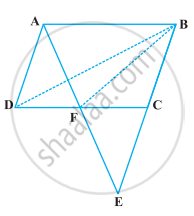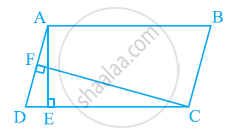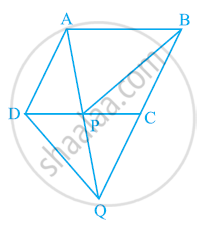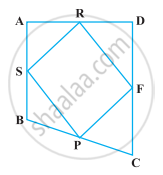Advertisements
Advertisements
प्रश्न
ABCD is a parallelogram in which BC is produced to E such that CE = BC (Figure). AE intersects CD at F. If ar (DFB) = 3 cm2, find the area of the parallelogram ABCD.
उत्तर
Given: ABCD is a parallelogram in which BC is produced to E such that CE = BC. C is the mid-point BE and ar (ΔDFB) = 3 cm2.
In triangle, ADF and triangle EFC,
∠DAF = ∠CEF ...[Alternate interior angle]
AD = CE ...[AD = BC = CE]
∠ADF = ∠FCE ...[Alternate interior angle]
So, ΔADF ≅ ΔECF ...[By SAS rule of congruence]
Now, ΔADF ≅ ΔECF ...[By SAS rule of congruence]
DF = CF ...[CPCT]
As BF is the median of triangle BCD.
ar (ΔBDF) = `1/2` ar (BCD) ...(i) [Median divides a triangle into two triangle of equal area]
As we know that a triangle and parallelogram are on the same base and between the same parallels then area of the triangles is equal to half the area of the parallelogram.
ar (ΔBCD) = `1/2` ar (ABCD) ...(ii)
ar (ΔBDF) = `1/2 {1/2 "ar (ABCD)"}` ...[By equation (i)]
3 cm2 = `1/4` ar (ABCD)
ar (ABCD) = 12 cm2
Hence, the area of the parallelogram is 12 cm2.
APPEARS IN
संबंधित प्रश्न
In the given figure, ABCD is parallelogram, AE ⊥ DC and CF ⊥ AD. If AB = 16 cm, AE = 8 cm and CF = 10 cm, find AD.

P and Q are any two points lying on the sides DC and AD respectively of a parallelogram ABCD. Show that ar (APB) = ar (BQC).
Parallelogram ABCD and rectangle ABEF are on the same base AB and have equal areas. Show that the perimeter of the parallelogram is greater than that of the rectangle.
In the following figure, ABCD is parallelogram and BC is produced to a point Q such that AD = CQ. If AQ intersect DC at P, show that
ar (BPC) = ar (DPQ).
[Hint: Join AC.]

In the below fig. ABCD and AEFD are two parallelograms. Prove that
(1) PE = FQ
(2) ar (Δ APE) : ar (ΔPFA) = ar Δ(QFD) : ar (Δ PFD)
(3) ar (ΔPEA) = ar (ΔQFD)
PQRS is a rectangle inscribed in a quadrant of a circle of radius 13 cm. A is any point on PQ. If PS = 5 cm, then ar (PAS) = 30 cm2.
If the mid-points of the sides of a quadrilateral are joined in order, prove that the area of the parallelogram so formed will be half of the area of the given quadrilateral (Figure).
[Hint: Join BD and draw perpendicular from A on BD.]

The diagonals of a parallelogram ABCD intersect at a point O. Through O, a line is drawn to intersect AD at P and BC at Q. Show that PQ divides the parallelogram into two parts of equal area.
ABCD is a trapezium in which AB || DC, DC = 30 cm and AB = 50 cm. If X and Y are, respectively the mid-points of AD and BC, prove that ar (DCYX) = `7/9` ar (XYBA)
In the following figure, ABCD and AEFD are two parallelograms. Prove that ar (PEA) = ar (QFD). [Hint: Join PD].

